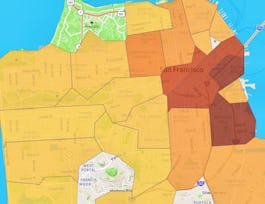This course will continue the introduction to Python programming that started with Python Programming Essentials and Python Data Representations. We'll learn about reading, storing, and processing tabular data, which are common tasks. We will also teach you about CSV files and Python's support for reading and writing them. CSV files are a generic, plain text file format that allows you to exchange tabular data between different programs. These concepts and skills will help you to further extend your Python programming knowledge and allow you to process more complex data.


Python Data Analysis
This course is part of Introduction to Scripting in Python Specialization
Taught in English
Some content may not be translated


Instructors: Scott Rixner
38,166 already enrolled
Included with 
Course
(881 reviews)
95%
Details to know

Add to your LinkedIn profile
2 quizzes
Course
(881 reviews)
95%
See how employees at top companies are mastering in-demand skills

Build your subject-matter expertise
- Learn new concepts from industry experts
- Gain a foundational understanding of a subject or tool
- Develop job-relevant skills with hands-on projects
- Earn a shareable career certificate


Earn a career certificate
Add this credential to your LinkedIn profile, resume, or CV
Share it on social media and in your performance review

There are 4 modules in this course
This module will teach you about Python's dictionary data type and its capabilities. Dictionaries are used to map keys to values within programs.
What's included
7 videos2 readings1 quiz
This module will teach you about storing tabular data within Python programs using lists and dictionaries.
What's included
4 videos2 readings1 quiz
This module will teach you the basics of CSV files and how to read them from Python programs. We will discuss the use of Python's csv module to help you access tabular data in CSV files.
What's included
8 videos4 readings2 app items
This module will teach you how to sort data in Python. You will organize and analyze tabular data.
What's included
6 videos3 readings1 app item
Offered by
Recommended if you're interested in Software Development

University of Illinois at Urbana-Champaign

Howard University

Howard University

Howard University
Why people choose Coursera for their career




Learner reviews
Showing 3 of 881
881 reviews
- 5 stars
76.16%
- 4 stars
16.68%
- 3 stars
4.99%
- 2 stars
1.36%
- 1 star
0.79%
New to Software Development? Start here.

Open new doors with Coursera Plus
Unlimited access to 7,000+ world-class courses, hands-on projects, and job-ready certificate programs - all included in your subscription
Advance your career with an online degree
Earn a degree from world-class universities - 100% online
Join over 3,400 global companies that choose Coursera for Business
Upskill your employees to excel in the digital economy
Frequently asked questions
Access to lectures and assignments depends on your type of enrollment. If you take a course in audit mode, you will be able to see most course materials for free. To access graded assignments and to earn a Certificate, you will need to purchase the Certificate experience, during or after your audit. If you don't see the audit option:
The course may not offer an audit option. You can try a Free Trial instead, or apply for Financial Aid.
The course may offer 'Full Course, No Certificate' instead. This option lets you see all course materials, submit required assessments, and get a final grade. This also means that you will not be able to purchase a Certificate experience.
When you enroll in the course, you get access to all of the courses in the Specialization, and you earn a certificate when you complete the work. Your electronic Certificate will be added to your Accomplishments page - from there, you can print your Certificate or add it to your LinkedIn profile. If you only want to read and view the course content, you can audit the course for free.
If you subscribed, you get a 7-day free trial during which you can cancel at no penalty. After that, we don’t give refunds, but you can cancel your subscription at any time. See our full refund policy.

